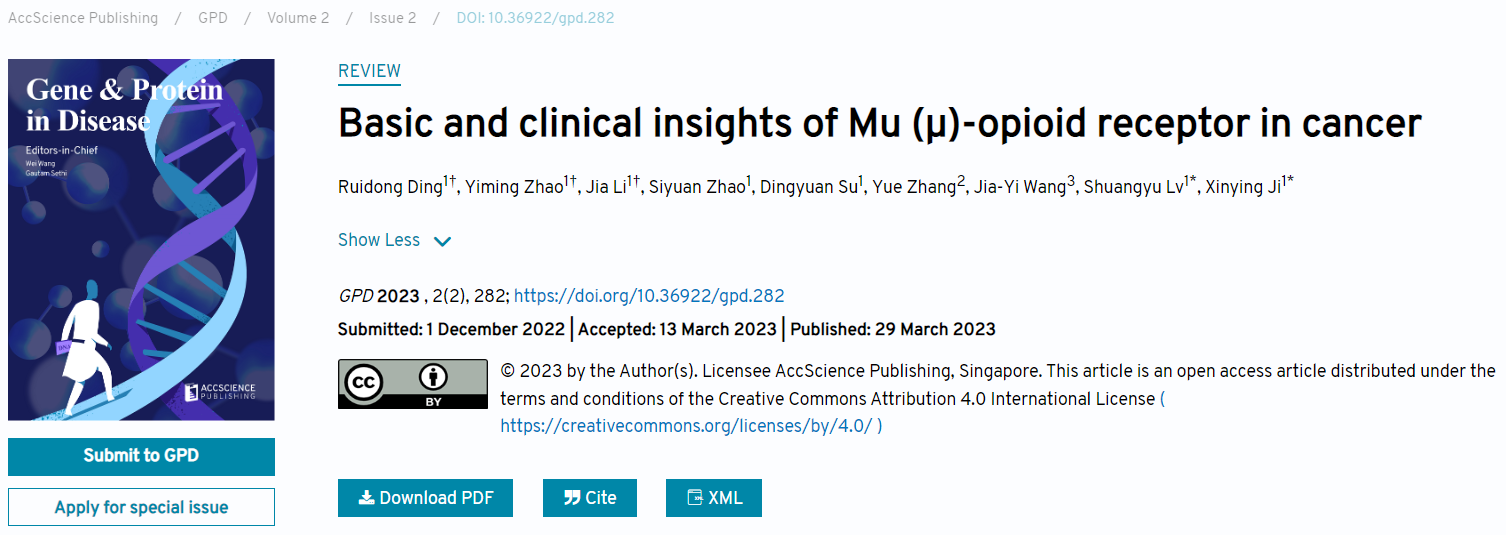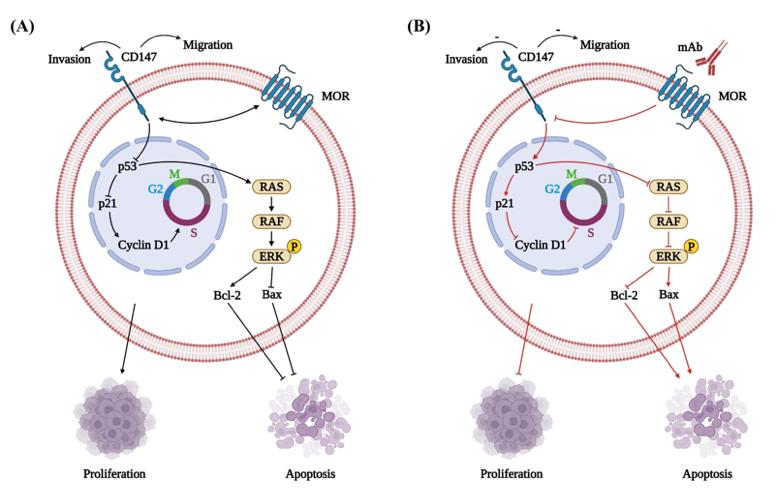Recently, the article entitled "Basic and clinical insights of mu-opioid receptor in cancer" was published in the international journal Gene & Protein in Disease (GPD). The co-first authors are Ding Ruidong, Zhao Yiming and Li Jia, as the of undergraduate students in the Lv Shuangyu research group of the Henan Provincial Nuclear Protein Gene Regulation International Joint Laboratory.

Nowadays, cancer is still one of the biggest public health problems in the world, which greatly endangers the health of all mankind. Most patients with intermediate and advanced cancer will suffer from cancer pain, which seriously affects the quality of life of cancer patients. Based on this, opioids drugs such as morphine are mostly used in clinical treatment to relieve or suppress patients' pain. Opioids exert analgesic effects by binding to specific receptors (opioid receptors) and are commonly used to treat acute severe pain and chronic pain. Opioid receptors are G-protein-coupled receptors distributed in the cell membrane, cytoplasm, or nucleus, including the Mu-opioid receptor (MOR), Kappa-opioid receptor (KOR), Delta-opioid receptor (DOR), and pain-sensitive peptide opioid receptor, each type of opioid receptor is divided into multiple subtypes. Among them, MOR is the main receptor of opioids and is widely present in the central and peripheral nervous systems. The distribution of MOR and its related drugs have always been the focus and hotspot of opioid research, especially the relationship between MOR and tumor recurrence and metastasis.

The figure shows the effect of MOR and CD147 interaction on tumor progression
This paper explores the possible role of MOR in tumor treatment by systematically reviewing the structure and physiological function of MOR, the pathophysiology of tumors, and focusing on the impact of MOR expression on tumorigenesis and development. On the one hand, highly expressed MOR can promote cancer cell proliferation by activating Akt/mTOR, cAMP-PKA signaling pathway and MAPK-related signaling pathway, which directly leads to poor prognosis and shortened PFS and OS in LSCC10 patients and increased cancer cell proliferation and chemotherapy resistance in metastatic prostate cancer. The expression of downregulated MOR can inhibit the progression of human liver cancer. On the other hand, MOR activation can inhibit angiogenesis and tumor development of LCCs by inhibiting the HIF-1/p38MAPK pathway. It suggests that opioids and their main role in the MOR receptor may have a "dual effect" relationship with the development of cancer. The interaction of MOR with receptors such as PD-1 and OGFR may become a new research direction. Further exploring the specific mechanism of the influence of MOR on tumor pathology, blocking the signaling pathway that promotes tumorigenesis and development, and also using MOR to promote the development of immunotherapy. In short, MOR can be used as a biomarker for some cancers and a novel biological target for immunotherapy, which can play a great role in predicting the prognosis of cancer patients and immunotherapy innovation, providing new ideas for cancer therapy and providing value for improving the quality of life of cancer patients.
The grade 2019 undergraduate students Ding Ruidong, Zhao Yiming and Li Jia are the co-first authors, Professor Ji Xinxing and Associate Professor Lv Shuangyu are the corresponding authors of the paper, and Henan University is the first unit of the paper.
Authors’ impressions
The Gene & Protein in Disease (GPD) is an international journal focusing on the latest research progress in genes, proteins and diseases, mainly publishing the latest research results in the field of molecular medicine and translational medicine. The journal has a number of excellent and responsible reviewers and editors, who can efficiently complete the review and review work, and put forward comprehensive and pertinent comments and suggestions. Now, GPD is celebrating its first anniversary, and it is an honor to receive the good news of the article being received at this time. We wish GPD an early growth into a high-level international journal, establishment of an international biomedical journal with Chinese characteristics and China-led, to lead the trend of medical science and technology, and contribute to the cause of healthy China.
Full text link:
https://accscience.com/journal/GPD/2/2/10.36922/gpd.282
日前,河南省核蛋白基因调控国际联合实验室(简称实验室)吕双瑜课题组本科生丁睿东、赵一鸣、李佳为共同第一作者的文章被国际英文期刊Gene & Protein in Disease(简称GPD)接收,题目为 “Basic and clinical insights of mu-opioid receptor in cancer”。
现如今癌症仍是全球最大的公共卫生问题之一,极大的危害全人类的健康。大多数中晚期癌症的病人会遭受癌痛的折磨,严重影响到了癌症患者的生活质量。基于此,临床治疗中多采用吗啡等阿片类药物来缓解或抑制病人的疼痛。阿片类药物通过与特定受体(阿片受体)结合而发挥镇痛等作用,常用于治疗急性剧烈疼痛和慢性疼痛。阿片受体是一种分布于细胞膜、细胞质或细胞核中的G蛋白偶联受体,包括Mu-阿片受体(MOR)、Kappa-阿片受体(KOR)、Delta-阿片受体(DOR)和痛敏肽阿片受体,每种类型的阿片受体又分为多种亚型。其中,MOR是阿片类药物的主要作用受体,广泛存在于中枢和外周神经系统。MOR的分布位置及其相关药物的研究一直是阿片类药物研究的重点和热点,特别是MOR与肿瘤复发和转移的关系。

图为MOR和CD147相互作用对肿瘤进展的影响
该论文通过系统综述MOR的结构与生理功能、肿瘤的病理生理以及重点描述MOR的表达对肿瘤发生发展的影响来,探讨MOR在肿瘤治疗中可能发挥的作用。一方面,高表达的MOR可通过激活Akt/mTOR、cAMP-PKA信号通路和MAPK相关信号通路促进癌细胞增殖,直接导致LSCC10患者预后不良,患者PFS和OS缩短转移性前列腺癌,前列腺癌细胞增殖和化疗耐药性增加。而下调的MOR的表达则可以抑制人肝癌的进展。另一方面,MOR激活可通过抑制HIF-1a/p38MAPK通路抑制LCC的血管生成和肿瘤发展。表明阿片类药物及其主要作用的MOR受体与癌症的发生可能存在“双重作用”关系。MOR与PD-1和OGFR等受体的相互作用或将成为一个全新的研究方向。进一步探究MOR对肿瘤病理影响的具体机制,阻断促进肿瘤发生发展的信号通路,也是利用MOR来促进免疫疗法发展的途径。总之,MOR可作为部分癌症的生物标志物以及免疫疗法的新型生物靶点,其能够在预测癌症病人的预后和免疫疗法创新等方面将发挥极大作用,为癌症疗法提供新思路以及为提高癌症病人的生存质量提供价值。
实验室2019级本科生丁睿东、赵一鸣、李佳为共同第一作者,姬新颖教授、吕双瑜副教授为该论文的通讯作者,河南大学为论文的第一单位。
作者感言:
英文期刊Gene & Protein in Disease(简称GPD)是专注于基因、蛋白质和疾病最新研究进展的国际期刊,主要发表分子医学和转化医学领域的最新研究成果。期刊拥有多名优秀、负责的审稿专家和编辑,能够高效的完成审稿和审核工作,并提出全面、中肯的审稿意见。现今,GPD迎来创刊一周年,很荣幸能够在此时刻收到文章被接收喜讯。预祝GPD早日成长为高水平的国际期刊,创立中国特色、中国主导的国际生物医学期刊,为建设创新型国家、引领医学科技潮流增光添彩,为健康中国事业添砖加瓦。
论文链接:
https://accscience.com/journal/GPD/2/2/10.36922/gpd.282






